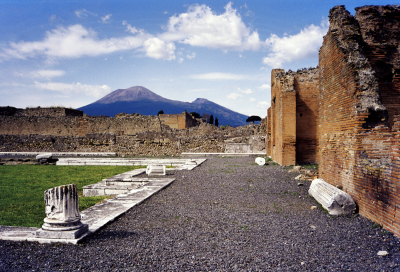Of the many eruptions of Mount Vesuvius, a major stratovolcano in southern Italy, the most famous is its eruption in 79 AD, which was one of the deadliest in European history. The eruption of Mount Vesuvius in 79 AD has been called one of the most well-known volcanic eruptions in history.In the autumn of 79 AD, Mount Vesuvius violently spewed forth a deadly cloud of super-heated tephra and gases to a height of 33 km (21 mi), ejecting molten rock, pulverized pumice and hot ash at 1.5 million tons per second, ultimately releasing 100,000 times the thermal energy of the atomic bombings of Hiroshima and Nagasaki. The event gives its name to the Vesuvian type of volcanic eruption, characterised by eruption columns of hot gases and ash exploding into the stratosphere, although the event also included pyroclastic flows associated with Pelean eruptions.
At the time, the region was a part of the Roman Empire, and several Roman cities were obliterated and buried underneath massive pyroclastic surges and ashfall deposits, the best known being Pompeii and Herculaneum. After archaeological excavations revealed much about the lives of the inhabitants, the area became a major tourist attraction, and is now a UNESCO World Heritage Site and part of Vesuvius National Park.
The total population of both cities was over 20,000. The remains of over 1,500 people have been found at Pompeii and Herculaneum so far, although the total death toll from the eruption remains unknown.
Mount Vesuvius ( viss-OO-vee-əs; Italian: Vesuvio [veˈzuːvjo, -ˈsuː-]; Neapolitan: 'O Vesuvio [o vəˈsuːvjə], also 'A muntagna or 'A montagna; Latin: Vesuvius [wɛˈsʊwɪ.ʊs], also Vesevius, Vesvius or Vesbius) is a somma-stratovolcano located on the Gulf of Naples in Campania, Italy, about 9 km (5.6 mi) east of Naples and a short distance from the shore. It is one of several volcanoes which form the Campanian volcanic arc. Vesuvius consists of a large cone partially encircled by the steep rim of a summit caldera, caused by the collapse of an earlier and originally much higher structure.
The eruption of Mount Vesuvius in AD 79 destroyed the Roman cities of Pompeii, Herculaneum, Oplontis and Stabiae, as well as several other settlements. The eruption ejected a cloud of stones, ashes and volcanic gases to a height of 33 km (21 mi), erupting molten rock and pulverized pumice at the rate of 6×105 cubic metres (7.8×105 cu yd) per second. More than 1,000 people are thought to have died in the eruption, though the exact toll is unknown. The only surviving eyewitness account of the event consists of two letters by Pliny the Younger to the historian Tacitus.Vesuvius has erupted many times since and is the only volcano on the European mainland to have erupted within the last hundred years. Today, it is regarded as one of the most dangerous volcanoes in the world because of the population of 3,000,000 people living near enough to be affected by an eruption, with 600,000 in the danger zone, making it the most densely populated volcanic region in the world. It has a tendency towards violently explosive eruptions, which are now known as Plinian eruptions.

 English
English  español
español  français
français  português
português  русский
русский  العربية
العربية  简体中文
简体中文 
